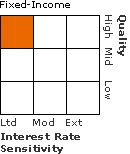| Goldman Sachs VIT Government MMkt Instl |
|
 |
|
| Release date as of 2025-08-31. Data on page is subject to change. |
|
|
|
|
|
| Total Fund Assets ($ Mil) |
| 3,868.86 |
|
|
|
|
| Investment Objective & Strategy |
|
| The investment seeks to maximize current income to the extent consistent with the preservation of capital and the maintenance of liquidity by investing exclusively in high quality money market instruments.
|
|
| The fund pursues its investment objective by investing only in "government securities," as such term is defined in or interpreted under the Investment Company Act of 1940, as amended ("Investment Company Act"), and repurchase agreements collateralized by such securities. "government securities" generally are securities issued or guaranteed by the United States or certain U.S. government agencies or instrumentalities ("U.S. government securities"). |
|
|
| Morningstar Category: Money Market-Taxable |
|
| These portfolios invest in short-term money market securities in order to provide a level of current income that is consistent with the preservation of capital. These funds do not designate themselves as Prime in Form N-MFP.
|
|
|
| There are no additional fund specific investment risks (e.g. liquidity risk, currency risk, foreign investment risk, etc.) associated with this fund beyond the normal risks generally associated with investing in a mutual fund. |
|
|
| % of Net Assets |
 |
U.S. Stocks |
0 |
 |
Non-U.S. Stocks |
0 |
 |
Bonds |
0 |
 |
Cash |
100 |
 |
Other |
0 |
|
|
 |
| Data through 2025-08-31 |
|
|
|
|
|
|
|
|
|
| Credit and Counterparty, Loss of Money, Not FDIC Insured, Interest Rate, Market/Market Volatility, Restricted/Illiquid Securities, U.S. Federal Tax Treatment, U.S. Government Obligations, Shareholder Activity, Money Market |
|
| Show Risk Definitions |
|
|
| Inception Date: 2013-10-16 |
|
| Management Team (2006-01-09) |
|
| Team Managed |
|
|
|
| Goldman Sachs Asset Management, L.P. |
|
|
|
|
|
|
|
|

© Copyright 2025 Morningstar, Inc. All rights reserved. Morningstar, the Morningstar logo, Morningstar.com, Morningstar Tools are either trademark or service marks of Morningstar, Inc. The information contained herein: (1) is proprietary to Morningstar and/or its content providers; (2) may not be copied or distributed; and (3) is not warranted to be accurate, complete or timely. Neither Morningstar nor its content providers are responsible for any damages or any losses arising from any use of information. Past performance is no guarantee of future performance. |
|
Past performance is no guarantee of future results.
Returns will vary and shares may be worth more or less than their original cost when sold.
|
|






